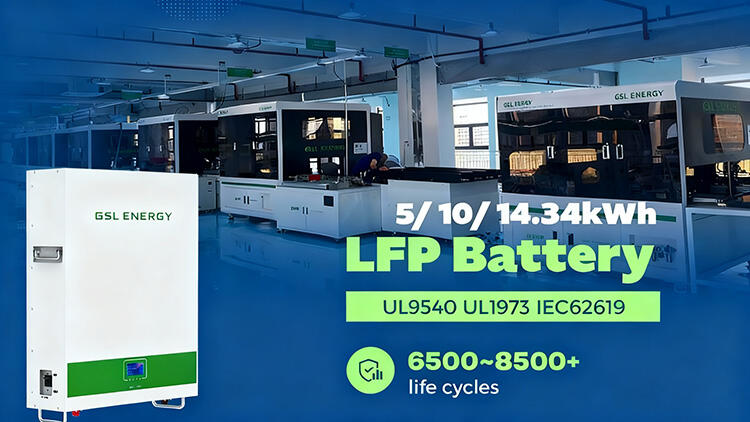เหตุใดแบตเตอรี่สำหรับจัดเก็บพลังงานในบ้านถึงจะกลายเป็นสิ่งที่ "ต้องมี" ภายในปี 2025
ด้วยราคาค่าไฟฟ้าที่สูงขึ้นและต้นทุนการติดตั้งระบบโฟโตโวลเทอิกส์ การจัดเก็บพลังงานสำหรับบ้านพักอาศัยได้เปลี่ยนจากทางเลือกเสริมไปเป็นเครื่องมือประหยัดค่าใช้จ่ายที่คุณไม่ควรพลาด แผงโซลาร์เซลล์จะผลิตไฟฟ้าในช่วงเวลากลางวันและเก็บไว้ในแบตเตอรี่ จากนั้นปล่อยออกมาใช้ในเวลากลางคืนเมื่อค่าไฟฟ้าสูง นอกจากนี้ยังสามารถใช้เป็นแหล่งจ่ายไฟฉุกเฉินในช่วงที่ไฟฟ้าดับได้อีกด้วย อย่างไรก็ตาม การเลือกแบตเตอรี่ที่เหมาะสมถือเป็นสิ่งสำคัญมาก การเลือกผิดอาจทำให้เสียเงินเพิ่ม และยังก่อให้เกิดความเสี่ยงด้านความปลอดภัยได้ ในบทความนี้ เราขอเสนอการวิเคราะห์อย่างละเอียดเกี่ยวกับวิธีการเลือกระบบจัดเก็บพลังงานสำหรับบ้าน

I. การเปรียบเทียบแก่นหลัก: แบตเตอรี่ลิเธียม-เหล็ก-ฟอสเฟต เทียบกับ แบตเตอรี่ตะกั่วกรด: อันไหนเหมาะกับการใช้งานในบ้านพักอาศัยมากกว่ากัน
(I) แบตเตอรี่ลิเธียม-เหล็ก-ฟอสเฟต (LiFePO4): ทางเลือกหลักในปี 2025
แบตเตอรี่ประเภทนี้เหมือนกับ "นักแข่งขันที่ทนทานยาวนาน" ในวงการจัดเก็บพลังงาน ซึ่งเหมาะอย่างยิ่งสำหรับการใช้งานในบ้านระยะยาว ข้อได้เปรียบหลักของมันแสดงออกได้ในสี่ด้าน:
อายุการใช้งานที่ยาวนานกว่า: การลงทุนที่คุ้มค่าถึงสิบปี
แบตเตอรี่ลิเธียม-เหล็ก-ฟอสเฟตคุณภาพสูงสามารถใช้งานได้มากกว่า 6,000 รอบ ด้วยการชาร์จและปล่อยประจุทุกวัน แบตเตอรี่ชนิดนี้สามารถใช้งานได้อย่างเสถียรเป็นเวลาอย่างน้อย 16 ปี โดยยังคงความสามารถในการใช้งานได้ 80% หลังจากแต่ละรอบ ในทางตรงกันข้าม แบตเตอรี่ตะกั่วกรดจะสูญเสียประสิทธิภาพลงครึ่งหนึ่งหลังจากใช้งานไม่เกิน 2,000 รอบ ทำให้จำเป็นต้องเปลี่ยนใหม่ทุกๆ 2 ถึง 3 ปี
ดีไซน์กะทัดรัด: เหมาะสำหรับอพาร์ตเมนต์ขนาดเล็ก
ด้วยความจุเท่ากัน แบตเตอรี่ลิเธียมไอรอนฟอสเฟตจะมีน้ำหนักเพียงหนึ่งในสามของแบตเตอรี่ตะกั่ว-กรด และมีน้ำหนักเพียงครึ่งเดียว ตัวอย่างเช่น แบตเตอรี่ขนาด 10 กิโลวัตต์ชั่วโมงจะกินพื้นที่ระเบียงครึ่งหนึ่ง ในขณะที่แบตเตอรี่ลิเธียมไอรอนฟอสเฟตแบบติดผนังสามารถติดตั้งบนผนังได้โดยตรง โดยไม่กินพื้นที่บ้านพักอาศัยมากเกินไป
ปลอดภัยและควบคุมได้: มีความน่าเชื่อถือสูงกว่าสำหรับการใช้งานในที่พักอาศัย
มาพร้อมระบบจัดการแบตเตอรี่อัจฉริยะ (BMS) ที่ตรวจสอบแรงดัน อุณหภูมิ สถานะการชาร์จ และการคายประจุแบบเรียลไทม์ เพื่อป้องกันการชาร์จหรือคายประจุเกินขีดจำกัด นอกจากนี้ ลิเธียม-เหล็ก-ฟอสเฟตยังให้ความมั่นคงทางความร้อนเมื่ออุณหภูมิอยู่ที่ 200-300°C ทำให้ไม่เกิดการระเบิดแม้จะถูกเจาะ ก่อให้เกิดความปลอดภัยที่สูงกว่าแบตเตอรี่ลิเธียมไตรนามอย่างมาก การออกแบบกันน้ำตามมาตรฐาน IP65 ช่วยให้สามารถติดตั้งในสภาพแวดล้อมที่มีความชื้น เช่น ระเบียงและโรงรถ
คุ้มค่าในระยะยาว: ต้นทุนเริ่มต้นสูง แต่ต้นทุนรวมต่ำ
แบตเตอรี่ลิเธียม-เหล็ก-ฟอสเฟตขนาด 10 กิโลวัตต์-ชั่วโมง ต้องใช้เงินลงทุนเริ่มต้นประมาณ 15,000 หยวน และมีอายุการใช้งาน 8-10 ปี ในขณะที่แบตเตอรี่ตะกั่วกรดราคา 10,000 หยวน จำเป็นต้องเปลี่ยนประมาณทุกๆ 2 ปี ส่งผลให้ค่าใช้จ่ายรวมตลอด 5 ปี เท่ากับ 25,000 หยวน ซึ่งสูงเป็นสองเท่าของแบตเตอรี่ลิเธียม-เหล็ก-ฟอสเฟต
(II) แบตเตอรี่ตะกั่วกรด: เหมาะสำหรับการเปลี่ยนผ่านในระยะสั้นเท่านั้น
แบตเตอรี่ตะกั่วกรดเปรียบเสมือน "แรงงานชั่วคราวที่ประหยัดต้นทุน" ข้อดีของมันคือราคาเริ่มต้นที่ต่ำ (รุ่น 48 V 20 Ah มีราคาประมาณ 500 หยวนเท่านั้น) และมีศูนย์ซ่อมแซมจำนวนมาก อย่างไรก็ตาม ข้อเสียของมันก็มีความสำคัญไม่แพ้กัน:
ในฤดูหนาว อุณหภูมิต่ำกว่า 0°C จะทำให้ความจุลดลงถึง 30% ซึ่งโดยพื้นฐานแล้วทำให้ใช้งานไม่ได้สำหรับผู้ใช้ในภาคเหนือของจีน
ในฤดูร้อน แบตเตอรี่มักจะพองและรั่วเนื่องจากถูกแสงแดด โดยกรดภายในอาจกัดกร่อนพื้นผิวได้
จำเป็นต้องตรวจสอบอิเล็กโทรไลต์ทุกสัปดาห์ และเติมน้ำเดือนละครั้งเพื่อบำรุงรักษา ทำให้ไม่เหมาะอย่างยิ่งสำหรับครอบครัวที่มีตารางงานแน่น
สรุป: หากครอบครัววางแผนจะใช้แบตเตอรี่นานกว่าสามปี แบตเตอรี่ลิเธียมเหล็กฟอสเฟตคือทางเลือกเดียวที่คุ้มค่าทางเศรษฐกิจ เฉพาะผู้ที่มีงบประมาณจำกัดมาก หรือผู้ที่ย้ายบ้านทุกหนึ่งถึงสองปี ควรพิจารณาเปลี่ยนมาใช้แบตเตอรี่ตะกั่วกรด
III. ห้าประเด็นสำคัญในการเลือกแบตเตอรี่สำหรับบ้านในปี 2025
1. การจับคู่ความจุ: คำนวณจากปริมาณการใช้ไฟฟ้ารายวัน และหลีกเลี่ยงการเลือกความจุที่มากเกินไปโดยไม่จำเป็น
ความจุของระบบกักเก็บพลังงานสำหรับบ้านเรือนที่ใหญ่กว่า ไม่ได้หมายความว่าดีกว่าเสมอไป การเลือกควรพิจารณาจากความต้องการใช้ไฟฟ้าจริง ครัวเรือนขนาด 3-4 คน โดยทั่วไปใช้ไฟฟ้าประมาณ 15 กิโลวัตต์-ชั่วโมงต่อวันในฤดูร้อนและฤดูหนาว และ 8 กิโลวัตต์-ชั่วโมงในฤดูใบไม้ผลิและฤดูใบไม้ร่วง แบตเตอรี่ความจุ 5-15 กิโลวัตต์-ชั่วโมงถือว่าเพียงพอ การคำนวณทำได้ง่ายๆ โดยนำกำลังไฟฟ้า (กิโลวัตต์) ของเครื่องใช้ไฟฟ้าทุกชนิดในบ้านมาคูณกับเวลาใช้งานต่อวัน (ชั่วโมง) แล้วรวมกันเพื่อให้ได้ความต้องการรวมรายวัน จากนั้นคูณด้วยตัวคูณความปลอดภัย 0.8
2. อายุการใช้งานแบบไซเคิล: 6,000 ไซเคิลขึ้นไป
อายุการใช้งานของแบตเตอรี่ไม่ได้วัดแค่จำนวนรอบการชาร์จและปล่อยประจุเท่านั้น แต่คือจำนวนรอบจนกว่าความจุจะลดลงเหลือ 80% ของความจุเริ่มต้น ควรพิจารณาข้อมูลจำเพาะอย่างละเอียดก่อนซื้อ เช่น แบตเตอรี่ GSL ENERGY ที่ระบุว่า "6500+ รอบ" หมายความว่าหลังจากผ่านไป 6,500 รอบ ยังคงรักษาระดับความจุไว้ได้อย่างน้อย 80% แปลว่าไม่จำเป็นต้องเปลี่ยนใหม่ภายในสิบปี
3. การรับประกัน: 8-10 ปี ถือเป็นการรับประกันที่ดีที่สุด
แบตเตอรี่เป็นสินค้าสิ้นเปลือง และระยะเวลาการรับประกันสะท้อนถึงความมั่นใจของผู้ผลิตในผลิตภัณฑ์ของตนเอง โดยในปี 2025 แบรนด์ชั้นนำส่วนใหญ่จะให้การรับประกัน 10 ปี เช่น แบตเตอรี่ติดผนัง GSL ENERGY ที่รับประกัน 10 ปี พร้อมบริการซ่อมหรือเปลี่ยนฟรีหากเกิดการเสื่อมสภาพของความจุ ขัดข้อง หรือปัญหาอื่นๆ ควรหลีกเลี่ยงผลิตภัณฑ์ที่มีระยะเวลารับประกันเพียง 3-5 ปี
4. ความปลอดภัยและระบบอัจฉริยะ: คุณสมบัติเหล่านี้มีความจำเป็นอย่างยิ่ง
ระดับการป้องกัน: อย่างน้อย IP65 เหมาะสำหรับสภาพแวดล้อมที่ซับซ้อน เช่น ระเบียงและพื้นที่กลางแจ้ง
การตรวจสอบอัจฉริยะ: รองรับการเชื่อมต่อ WiFi และการตรวจสอบระยะไกลผ่านแอปพลิเคชัน ช่วยให้สามารถตรวจสอบระดับแบตเตอรี่ อุณหภูมิ และข้อผิดพลาดแบบเรียลไทม์ได้
ความสามารถในการขยายระบบ: สามารถเชื่อมต่อแบตเตอรี่หลายตัวแบบขนานกันได้ ทำให้คุณสามารถเพิ่มแบตเตอรี่ได้หากวางแผนจะเพิ่มรถยนต์ไฟฟ้าหรือเครื่องใช้ไฟฟ้าเพิ่มเติม
5. ความเข้ากันได้ของระบบ
หากคุณมีระบบโฟโตโวลเทกอยู่แล้ว การเลือกซื้อแบตเตอรี่ควรตรวจสอบความเข้ากันได้กับอินเวอร์เตอร์ที่มีอยู่ เช่น แบตเตอรี่แรงดันสูงควรใช้คู่กับอินเวอร์เตอร์แรงดันสูง และแบตเตอรี่แรงดันต่ำควรใช้คู่กับอินเวอร์เตอร์แรงดันต่ำ มิฉะนั้นอาจเกิดปัญหา เช่น ประสิทธิภาพการชาร์จและคายประจุต่ำ หรือขัดข้องบ่อยครั้ง เราขอแนะนำให้เลือกใช้อินเวอร์เตอร์แบบบูรณาการ เพราะติดตั้งพร้อมใช้งานได้ทันที ช่วยลดความยุ่งยากให้คุณ
IV. เซลล์แสงอาทิตย์สำหรับบ้านที่คุ้มค่าและแนะนำสำหรับปี 2025 (รุ่นที่ผ่านการทดสอบจาก GSL ENERGY)
ในฐานะแบรนด์ที่มีประสบการณ์ 15 ปีในด้านการจัดเก็บพลังงาน GSL ENERGY ส่งออกผลิตภัณฑ์ไปยัง 138 ประเทศ และแข่งขันโดยตรงกับ Tesla Powerwall ซึ่งแสดงให้เห็นถึงคุณภาพที่ได้รับการพิสูจน์แล้วในตลาดโลก โมเดลสามรุ่นต่อไปนี้ครอบคลุมความต้องการของบ้านเรือนที่แตกต่างกัน:
1. ติดผนัง 10 กิโลวัตต์ชั่วโมง (รุ่น: GSL-051200A-B-GBP2): ทางเลือกที่เหมาะสมที่สุดสำหรับครัวเรือนขนาดเล็กและขนาดกลาง
พารามิเตอร์หลัก: 51.2 V, 200 Ah, ความจุรวม 10 กิโลวัตต์ชั่วโมง รองรับ DoD 90% (ใช้งานได้จริง 9 กิโลวัตต์ชั่วโมง)
จุดเด่น: IP65 เหมาะสำหรับการติดตั้งบนระเบียง โดยไม่ต้องกังวลเรื่องฝนสาด
ตรวจสอบสถานะอัจฉริยะผ่าน Wi-Fi พร้อมแอปพลิเคชันมือถือสำหรับตั้งเวลาการชาร์จและปล่อยไฟฟ้าในช่วงเวลาพีคและนอกพีค
สามารถเชื่อมต่อแบบขนานได้สูงสุด 16 หน่วย และสามารถขยายความจุได้สูงสุดถึง 230 กิโลวัตต์ชั่วโมง เพื่อตอบสนองความต้องการที่หลากหลาย
กรณีตัวอย่าง: ครัวเรือนเฉลี่ย 3 ถึง 4 คน ใช้ไฟฟ้า 8 ถึง 12 กิโลวัตต์ชั่วโมงต่อวัน เมื่อใช้คู่กับแผงโฟโตโวลเทอิกขนาด 5 กิโลวัตต์ จะทำให้สามารถใช้ไฟฟ้าในช่วงเวลากลางวันได้เกือบฟรี
ข้อคิดเห็น: หลังติดตั้งผลิตภัณฑ์นี้ ผู้ใช้งานชาวโปแลนด์สามารถประหยัดได้ปีละ 30,000 ยูโร ผ่านการซื้อขายไฟฟ้าช่วงเวลาความต้องการสูงและต่ำ โดยมีระยะเวลาคืนทุนภายใน 1.5 ปี
2. พาวเวอร์ทาวเวอร์ 16 กิโลวัตต์-ชั่วโมง (รุ่น: GSL-W-16K): ผลิตภัณฑ์ยอดนิยมสำหรับบ้านที่ใช้ไฟฟ้ากำลังสูง
พารามิเตอร์หลัก: 51.2 โวลต์, 314 แอมป์-ชั่วโมง, 16 กิโลวัตต์-ชั่วโมง ออกแบบให้มีล้อเพื่อเคลื่อนย้ายได้ง่าย
ใบรับรองมาตรฐานระดับสากล: ผ่านการรับรองตามมาตรฐานสากลหลายฉบับ รวมถึง CB, IEC 62619 และ CE เพื่อความปลอดภัย
สถานการณ์การใช้งาน: บ้านที่มีเครื่องใช้ไฟฟ้ากำลังสูง เช่น เครื่องปรับอากาศแบบกลาง หรือเตาอบไฟฟ้า หรือต้องการชาร์จรถยนต์ไฟฟ้า
ข้อดีในการติดตั้ง: ไม่จำเป็นต้องเจาะผนัง เพียงแค่แกะกล่องแล้วเข็นไปวางในมุมห้อง แม้แต่ผู้เช่าก็สามารถติดตั้งได้
3. ตู้เก็บพลังงานแรงดันสูง (รุ่น: GSL-HV51200): ทางออกขั้นสุดยอดสำหรับบ้านเดี่ยว/คอนโดขนาดใหญ่
พารามิเตอร์สำคัญ: ออกแบบแบบโมดูลาร์ ตู้เดี่ยวสามารถขยายได้ตั้งแต่ 80 ถึง 140 กิโลวัตต์-ชั่วโมง ใช้เซลล์ที่ทนต่อการชาร์จ-ปล่อยไฟฟ้าได้ถึง 10,000 รอบ ส่งผลให้มีอายุการใช้งานยาวนานกว่าแบตเตอรี่ทั่วไปถึง 50%
ข้อได้เปรียบของระบบ: ความหนาแน่นพลังงานสูงด้วยสถาปัตยกรรม HESS ร่วมกับระบบระบายความร้อนด้วยของเหลว ทำให้มีประสิทธิภาพการชาร์จและคายประจุถึง 95% แม้อยู่ในสภาพแวดล้อมที่มีอุณหภูมิสูง
สถานการณ์การใช้งาน: บ้านพักขนาดใหญ่กว่า 500 ตารางเมตร ชุมชนที่อยู่อาศัยแบบหลายครอบครัว หรือแม้แต่ระบบออฟกริดขนาดเล็ก สามารถใช้งานได้อย่างสมบูรณ์โดยไม่ต้องพึ่งพาไฟฟ้าจากสาธารณูปโภค
ความเข้ากันได้ในระดับสากล: ผ่านการรับรองมาตรฐาน UL และ IEC เหมาะสำหรับติดตั้งในอเมริกาเหนือ ยุโรป และภูมิภาคอื่น ๆ โดยมีศูนย์บริการหลังการขายที่ปรับให้เหมาะสมกับแต่ละพื้นที่
V. เพราะเหตุใดครอบครัวจำนวนมากจึงเลือก GSL ENERGY?
ชื่อเสียงระดับโลกที่ยอดเยี่ยม: ผลิตภัณฑ์ของเราจำหน่ายใน 138 ประเทศ และได้รับการทดสอบจากลูกค้ามากกว่า 4,500 ราย พร้อมการใช้งานตั้งแต่บ้านพักอาศัยในเปอร์โตริโกไปจนถึงโครงการขนาดใหญ่ในอิสราเอล
การตอบสนองหลังการขายอย่างรวดเร็ว: เรามีศูนย์บริการเทคนิคในอเมริกาเหนือ ตะวันออกกลาง เยอรมนี และภูมิภาคอื่น ๆ ที่สามารถให้บริการนอกสถานที่ภายใน 24 ชั่วโมงหลังเกิดปัญหา
การปรับแต่ง: เรามีบริการปรับแต่ง OEM/ODM ตามรูปแบบการจัดวางภายในบ้านและการใช้ไฟฟ้า เช่น การติดตั้งเรียบกับผนัง และการเข้าคู่กับยี่ห้ออินเวอร์เตอร์เฉพาะทาง
มาตรฐานความปลอดภัยขั้นสูง: ผลิตภัณฑ์ทั้งหมดผ่านการรับรองอย่างเข้มงวด เช่น UL 9540, UL 1973 และ UL 9540a ทำให้เราเป็นหนึ่งในไม่กี่แบรนด์จีนที่สามารถตอบสนองมาตรฐานสมรรถนะสูงของอเมริกาเหนือ
VI. แนวทางการซื้อปี 2025
อย่าซื้อแบตเตอรี่ตะกั่วกรดเพียงเพราะราคาถูก คุณอาจประหยัดได้ไม่กี่พันบาทในระยะสั้น แต่ในระยะยาวจะต้องเสียเงินมากขึ้นกับการเปลี่ยนแบตเตอรี่บ่อยครั้ง
อย่าเลือกขนาดความจุแบตเตอรี่ใหญ่เกินความจำเป็นโดยไม่ไตร่ตรอง ควรเลือกตามการใช้ไฟฟ้ารายวันบวกเพิ่มอีก 20% การเลือกขนาดใหญ่เกินไปจะเป็นการสิ้นเปลืองเงิน
มองหาผลิตภัณฑ์ที่มีประกัน 10 ปี ควรระมัดระวังผลิตภัณฑ์ที่มีประกันน้อยกว่า 8 ปี เพราะอาจใช้เซลล์คุณภาพต่ำ
ให้ความสำคัญกับรุ่นอัจฉริยะเป็นอันดับแรก ระบบตรวจสอบผ่าน WiFi สามารถตรวจจับความผิดปกติล่วงหน้า ช่วยป้องกันไฟดับได้
ในปี 2025 แบตเตอรี่ลิเธียม-เหล็ก-ฟอสเฟตจะเป็นแรงผลักดันหลักในตลาดการจัดเก็บพลังงานสำหรับบ้าน การเลือก GSL ENERGY ที่มีการรับประกันคุณภาพและเทคโนโลยีขั้นสูง จะช่วยลดค่าไฟฟ้าของคุณ พร้อมทั้งให้ความมั่นคงด้านพลังงานนานกว่าหนึ่งทศวรรษ


